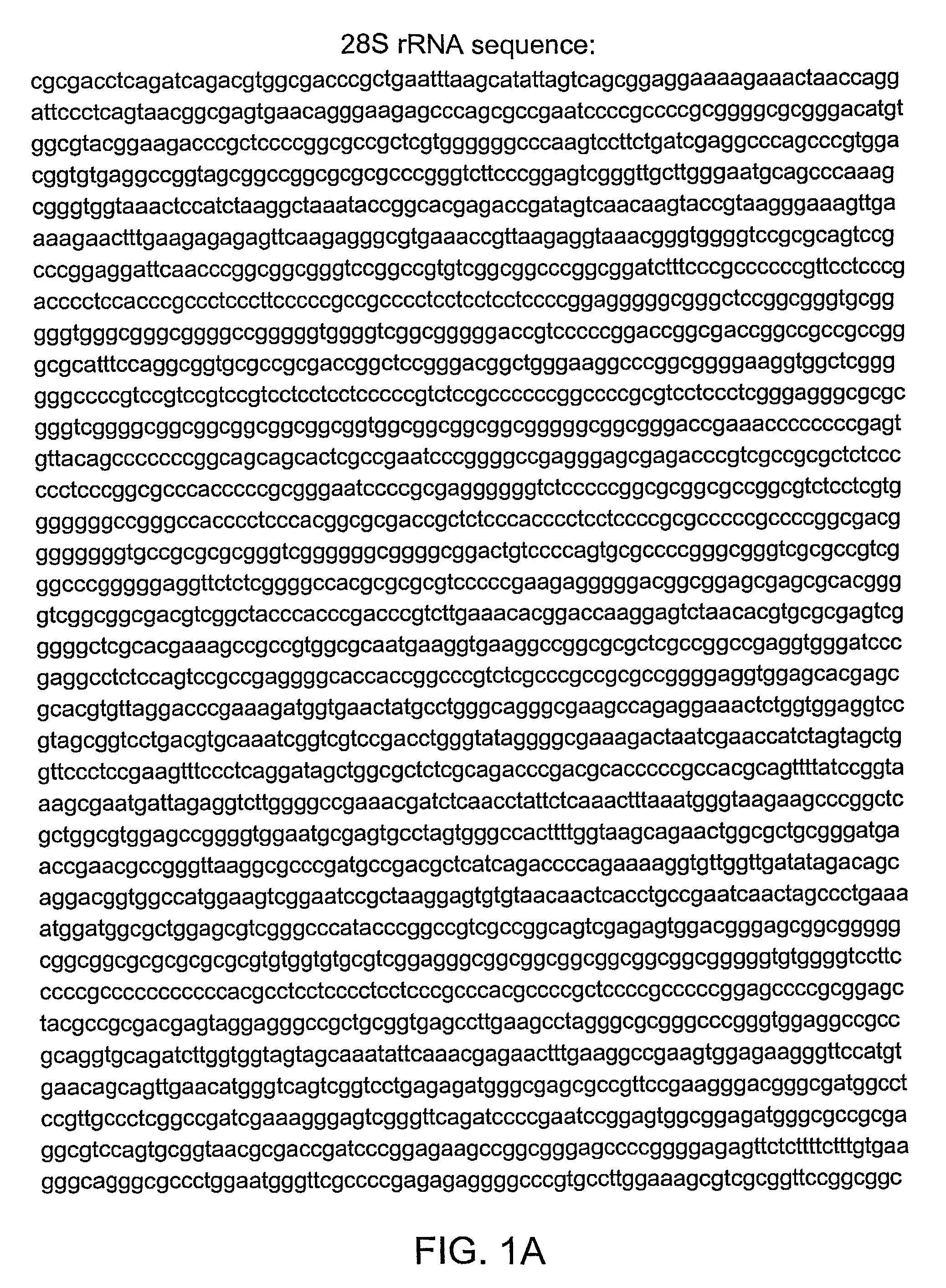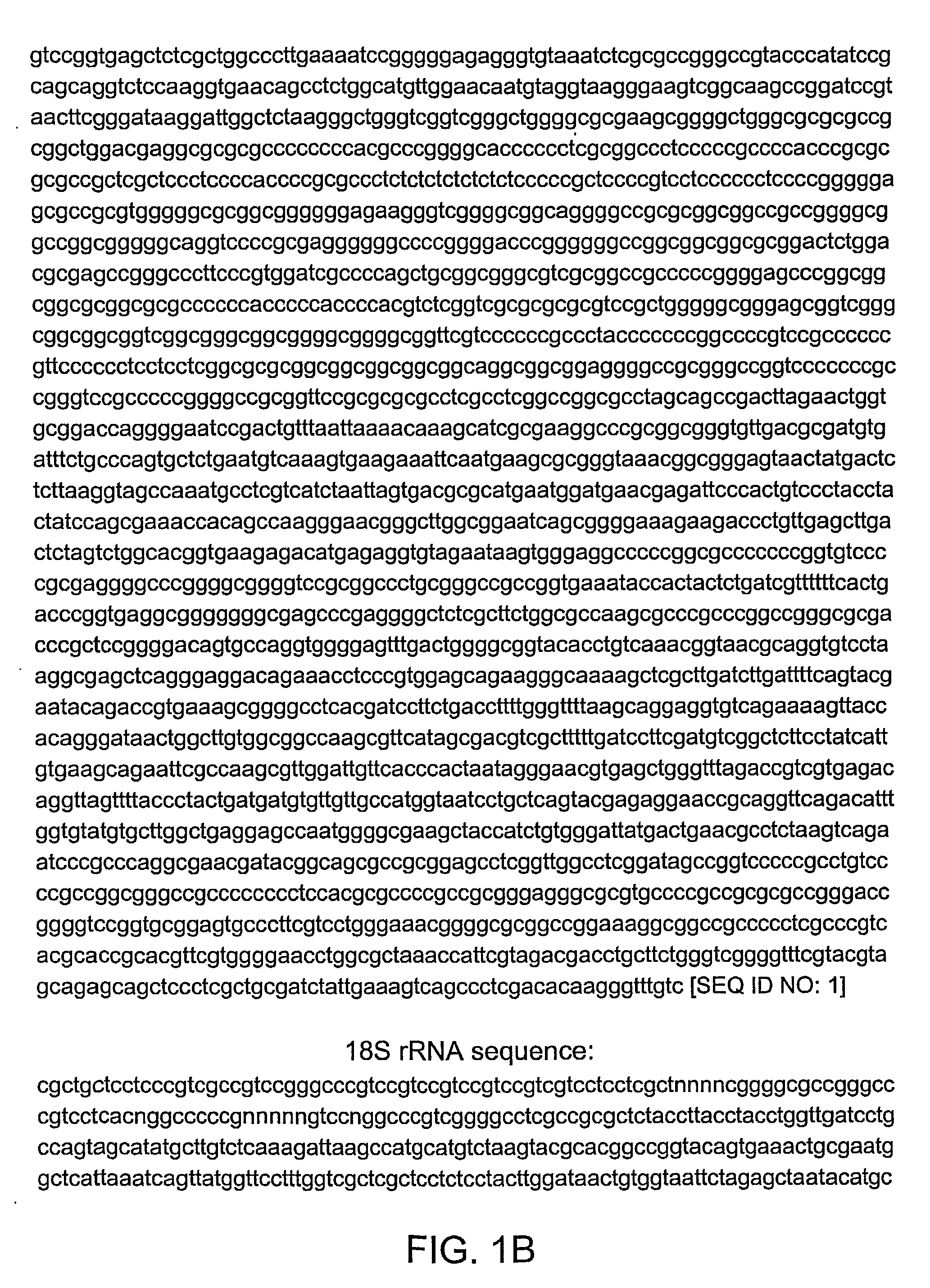SUBTRACTIVE SEPARATION AND AMPLIFICATION OF NON-RIBOSOMAL TRANSCRIBED RNA (nrRNA)
a technology subtraction separation, which is applied in the field of subtraction separation and amplification of non-ribosomal transcribed rna (nrrna), can solve the problems of reducing the efficiency of hybridization between the targeting region and the complementary targeted region, affecting the hybridization between the bridging region, and difficult to design an assay to determine expression levels
- Summary
- Abstract
- Description
- Claims
- Application Information
AI Technical Summary
Benefits of technology
Problems solved by technology
Method used
Image
Examples
example 1
[0055]This example describes a method of recovering mRNA from paraffin-embedded tissues by subtraction with oligonucleotides complementary to rRNA.
[0056]Five 10 micron sections of paraffin-embedded, benign prostatic hyperplasia tissues are extracted 3× with xylene to remove the paraffin and 3× with ethanol. After air drying, the tissue is incubated in 100 μl of proteinase K buffer at 50° C. for four days, with additional aliquots of proteinase K buffer added every 12 hours. The proteinase K buffer comprises 10 millimolar Tris (pH 8), 5 millimolar EDTA, 100 millimolar NaCl, 0.1% SDS, and 2 μg / mL proteinase K. The RNA is then isolated using total RNA isolation methods, such as lysis in guanidium thiocyanate followed by phenol-chloroform extraction and ethanol precipitation. A number of commercial kits are suitable for this purpose, such as Totally RNA (Ambion), Perfect RNA Eukaryotic Kit (Eppendorf, Westbury, N.Y.), and RNeasy kit (Qiagen, Valencia, Calif.). The RNA is extracted accor...
example 2
[0059]This example demonstrates a method of preparing probes for use in the invention.
[0060]To generate single-stranded DNA fragments complementary to rRNA, PCR primers are designed to amplify segments of the rRNA species that range in size from around about 100 base pairs up to the full-length rRNA template. The primers listed in FIGS. 3A-3C are designed to amplify fragments corresponding to all six rRNA species. The amplification reaction is performed using MasterTaq kit from Eppendorf according to the manufacturer's direction. The buffer is supplemented with 10% DMSO or 5% formamide when needed to improve the amplification of GC rich sequences. The amplification is performed for a total of 35 cycles of denaturation at 94° C. for 30 seconds, annealing at 60° C. for 30 seconds, and extension for 1 minute at 72° C. in the presence of 25 pmoles of the forward and reverse primers. The amplified rRNA fragments are used as templates to generate the single-stranded DNA complementary to t...
example 3
[0063]This example describes a method of analyzing nrRNA expression. In particular, this example describes reverse transcription and detection of p53 mRNA.
[0064]Reverse transcription is performed using the cMaster RTplus PCR kit (Eppendorf) using random primers or a combination of random primers and oligo dT primers according to the supplier's directions. Twenty nanograms of selected RNA (e.g., nrRNA isolated according to the method of Example 1) are used for each reaction. The reaction is stopped by heating at 70° C. for 15 minutes, followed by the addition of 1 unit of Rnase H and incubation at 37° C. for 20 minutes to degrade the RNA. The cDNA is now ready for RT-PCR. The transcription reaction is stored at −20° C.
[0065]To detect the p53 transcript, 1 μl of the cDNA is amplified using primers designed to amplify a portion of the p53 transcript. Examples of suitable primer pairs are:
F1: cttgccgtcccaagcaatggatg;(SEQ ID NO: 185)R1: ggagcttcatctggacctgggtc(SEQ ID NO: 246)(89 base pai...
PUM
| Property | Measurement | Unit |
|---|---|---|
| melting temperature | aaaaa | aaaaa |
| temperature | aaaaa | aaaaa |
| pH | aaaaa | aaaaa |
Abstract
Description
Claims
Application Information
 Login to View More
Login to View More - R&D
- Intellectual Property
- Life Sciences
- Materials
- Tech Scout
- Unparalleled Data Quality
- Higher Quality Content
- 60% Fewer Hallucinations
Browse by: Latest US Patents, China's latest patents, Technical Efficacy Thesaurus, Application Domain, Technology Topic, Popular Technical Reports.
© 2025 PatSnap. All rights reserved.Legal|Privacy policy|Modern Slavery Act Transparency Statement|Sitemap|About US| Contact US: help@patsnap.com



